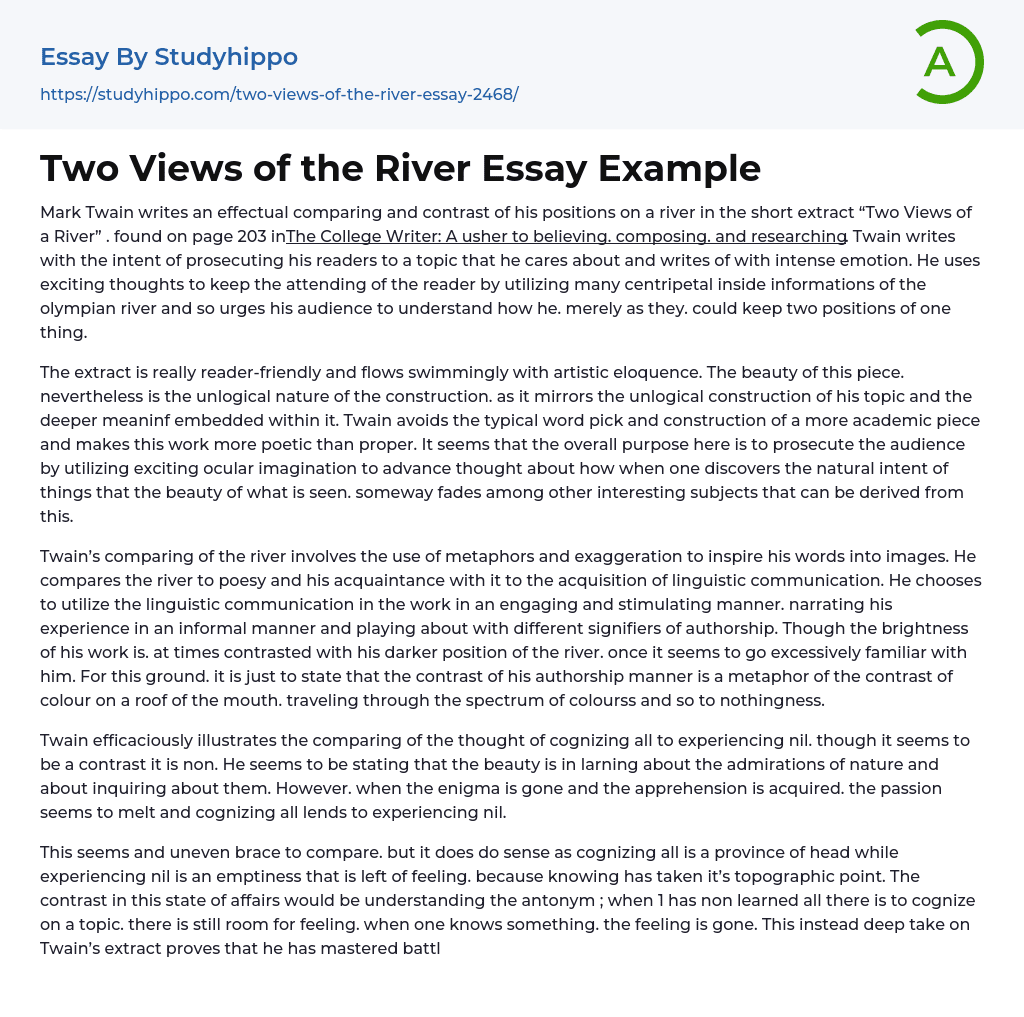In the short excerpt "Two Views of a River" from page 203 of "The College Writer: A Guide to Thinking, Composing, and Researching," Mark Twain effectively compares and contrasts his perspectives of a river. Twain writes with a passionate intent, seeking to engage his audience with a topic that he deeply cares about. He uses vivid descriptions of the grand river to maintain his readers' attention and encourages them to understand how he, like them, can hold two different views of one thing. The writing is reader-friendly and smooth-flowing with an artistic eloquence. The beauty of this piece lies in its illogical structure, which mirrors the illogical nature of the river and its deeper meaning. Instead of using typical academic language and structure, Twain employs poetic language to engage his audience. The primary purpose is to entice the readers
...using visual imagery to promote contemplation about how discovering the natural purpose of things can diminish their inherent beauty amidst other fascinating topics that can be derived from them. Twain's river comparison involves employing metaphors and exaggeration to inspire vivid imagery. He compares the river to poetry and his familiarity with it to learning a language.In an engaging and stimulating manner, he utilizes language in his work, narrating his experiences informally and playing with different authorship styles. Although the brightness of his work contrasts with his darker perspectives on the river, there are times when it seems all too familiar to him. It is thus apt to consider the contrast in his writing style as a metaphor for the contrast in colors on a palate that move through the spectrum and eventually lead to nothingness. Twai
effectively illustrates a comparison between the idea of knowing everything and feeling nothing. While it may seem like a contrast, he suggests that the beauty lies in learning about nature's wonders and inquisitively questioning them. However, once the mystery is solved and understanding is acquired, passion seems to fade away, leading to feeling nothing. This may seem like an odd comparison, but it makes sense since knowing everything is a state of mind whereas feeling nothing is emptiness left behind by the absence of emotions that knowing has replaced. Conversely, when one has not learned everything there is to know on a subject, there is still room for feeling. Once one knows something, the feeling is gone.In analyzing Twain's extract, it becomes apparent that he has a thorough understanding of the subject matter and aims to prompt readers to contemplate it. The text is also reader-friendly, intended to be read and reread to fully appreciate its significance. With each reading, it becomes more captivating, with eloquent language that reads like poetry. Twain even likens the river to a poem, with his own writing reflecting this style of poetry. The piece itself is colorful and beautiful, yet also contrasts acquisition and loss. When readers uncover the meaning behind Twain's words, the enigmatic search for significance is replaced with understanding. To delve deeper into this work, one could argue that this applies to anything in life, particularly in nature, which is Twain's subject matter. His illogical sentence structure mirrors nature's design and flows like a river, unrestricted by manmade academic conventions. It is worth noting that academic work has value, but Twain's approach offers a fresh perspective.The
organization and information conveyed in "Two Views of the River" caused Twain to lose the beauty he once saw in the river. Though the river still appeared useful, it lacked beauty for him. Twain compares this perspective to that of a physician who sees disease beneath a beautiful cheek, or any other professional viewpoint. He suggests this metaphor may also apply to his own composing, where professional organization and usefulness overshadow beauty. Consequently, his unconventional writing style allows for the beauty to remain present and his aim is for his audience to engage in the same journey of discovery that he experienced with the river. The narrative concludes with a comparison to a sunset where darkness follows once meaning is discovered. "Two Views of the River" is a captivating and poetic piece that lends itself to comparisons of the work with what Twain may be communicating about his art and profession. Just as nature is present in the piece, so too is Twain's human nature and natural writing style, which flow smoothly and engage readers to think deeply through comparisons and contrasts of what we see and know. Ultimately emphasizing his goal to inspire critical thought.Both discovery and uncertainty exist in professional standards. The novel "Two Positions of the River" by Couple Mark in The College Writer: A Guide to Thinking, Writing, and Researching highlights this concept. The book was published by Houghton Mifflin Harcourt Publishing Company in 2009 and written by VanderMey, Meyer, Van Rys, and Sebranek. The text is available in HTML format with the accompanying tags.
- Clothing essays
- Footwear essays
- Fashion design essays
- Cosmetic Surgery essays
- Jeans essays
- Oxygen essays
- Atmosphere essays
- Coral Reef essays
- Desert essays
- Earth essays
- Ocean essays
- Lake essays
- Sea essays
- Biodiversity essays
- Natural Environment essays
- Forest essays
- Soil essays
- Water essays
- Rainbow essays
- Ecosystem essays
- Volcano essays
- Wind essays
- Forestry essays
- Bottled Water essays
- Age Of Enlightenment essays
- Ethos essays
- Time essays
- Acceptance essays
- Meaning Of Life essays
- Reality essays
- Natural Law essays
- Political Philosophy essays
- Utilitarianism essays
- Existence essays
- Free Will essays
- Good And Evil essays
- Confucianism essays
- Relativism essays
- Conscience essays
- Environmentalism essays
- Empiricism essays
- Epistemology essays
- Ethics essays
- Existentialism essays
- Human Nature essays
- Individualism essays
- Metaphysics essays
- Philosophy Of Life essays
- Transcendentalism essays
- Truth essays




